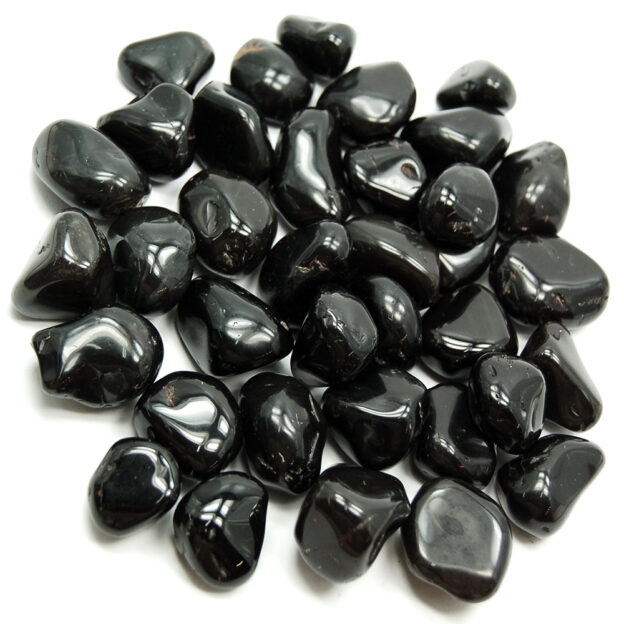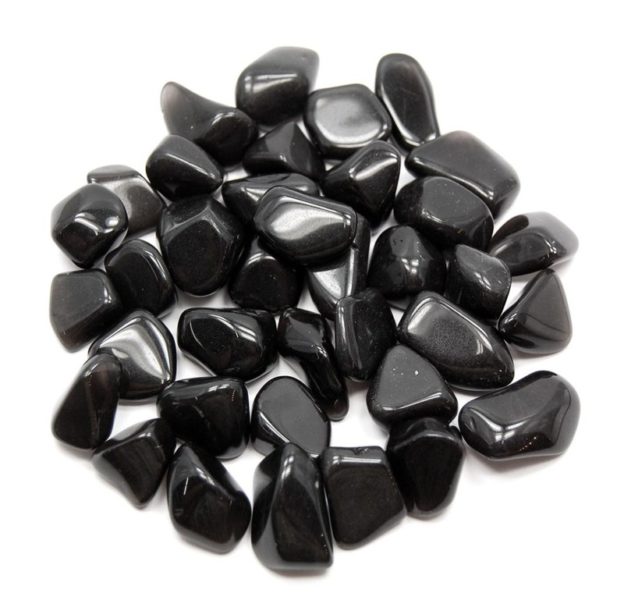The onyx,
the “stone walnut white vain” of the Middle Ages would give to see devils and
ghosts. Have these so-called evil powers been inspired by the diaphanous
creatures and white faces of the ancient cameos?
Ancient
civilizations were able to reveal all the sober beauty of onyx and sardonyx by
engraving them with infinite delicacy and their knowledge has never been
equaled.
Mineralogical characteristics of Onyx
Onyx is
included in the broad group of silicates and in the subclass of tectosilicates.
It integrates the large family of varied agates and chalcedonies, such as carnelian,
sardoine, chrysoprase, plasma or heliotrope.
Onyx, of
essentially siliceous composition, has a vitreous luster, an important hardness
of 7/10. It is formed at low temperatures and occurs in massive aggregates or
nodular sometimes flattened by the movement of water.
The great
feature of onyx is the alternation of black bands, or very brown, with white
bands. Other chalcedonies can mingle with onyx by forming layers of different
colors. The names of these varieties evoke their associations:
- Sardonyx (sardoine and onyx)
- Agatonyx (agate and onyx)
- Jasponyx (jasper and onyx)
These
semi-precious stones with colored layers are called “banded”.
Confusions and Deceitful Appellations
The true
black and white striped onyx sometimes takes the name of onyx “arabic or
arabica” or “oriental onyx”. But there are many misleading names
and confusions. For example:
- Black onyx is often called black monochrome chalcedony.
- The “onyx of Peru” is actually a pale pink stone
from the group of carbonates called manganocalcite.
- The onyx-marble also called “onyx limestone”
or “onyx-marble” consists of a mixture of calcite and aragonite, its
composition has nothing to do with that of onyx. No more than the spurious
“Mexican onyx” which is also similar to the marbles?
The onyx becomes scarce hence the temptation to
produce it artificially. Solutions of ammonium chloride and cobalt are used to
obtain a dark color, often unstable over time, on a chalcedony or a uniform
agate. A regular clear coat is then removed by removing the excess shade with
hydrochloric acid.
The diapers of Onyx
The most
common onyx has two parallel layers. Nicolino, nicollino or nichetto (from
Italian onicolo) are called small onyxes with a thin black or bluish upper
layer. Three-layer onyx is in great demand and rarities at four, five or even
six layers, even more so.
Provenances of Onyx
- South Africa
- Argentina
- Bolivia
- Brazil
- United States
- India
- Iran
- Italy
- Madagascar
- Mexico
- Siberia
- Turkey
- Uruguay
Etymology of the word “Onyx”
Onyx means “nail”
or “claw “in Greek (onux in Latin). Formed on the same basis,
“onychophagia” means for example the compulsive habit of eating and
eating one’s nails.
In ancient
times, several minerals, and even shells, more or less resembling nails are
called onyx. It seems nevertheless that the Greek word onychion and the Latin
expression gemma onyche used by Pliny (1st century AD) particularly designate a
variety of agate corresponding to the modern onyx.
As Buffon
explains, “the Greeks formed an elegant and mythological origin with onyx”. Thus,
the legend tells that the little god of love Eros (the Cupid of the Romans)
uses one of his arrows to cut the nails of his sleeping mother, Venus. The
mischievous flies off and drops the trimmings on the shore of India. The
Parques, three sister goddesses responsible for presiding over destinies,
collect them and transform them into stones called since “onyx”.
From the
Middle Ages, one finds indifferently the forms: onisse , onice , onix or onyce
.
Onyx through History
In ancient
times
Onyx comes
from India or Arabia. The most beautiful ones would come from the Shibam Mountain
near Mareb, capital of the prestigious kingdom of Saba (today under the sands
of Yemen in the region of Hadramout). The large size of onyx blocks used always
amaze historians and scientists.
All the
peoples of antiquity skilfully use onyx.
In Abydos, Egypt, a large number of plates, vases and large onyx jars
were discovered. Onyx earrings are frequently found in funerary temples. The
Romans make signet rings engraved with various symbols.
The Cabinet
of Medals retains a Phoenician seal dating from 780 BC representing with great
finesse the child-sun god Nefertoum among lotus flowers.
Tourmaline Stone Benefits
According
to the Greek historian Appian, Mithridates the Great, King of the Bridge around
100 BC (northern Turkey today), possessed two thousand gold vases and onyx.
After his victory, Pompey will bring to Rome the precious vases, the number of
which may have been exaggerated. Their material is not known with certainty
because onyx also means alabastrite, a kind of veined white marble. This
oriental alabaster is used to make containers used to store precious ointments
and scented balms such as benzoin or myrrh. This odoriferous resin is said to
be at the origin of murrhin or onyx murrheus vases frequently mentioned in
ancient stories.
The vessels
of Mithridates were perhaps in alabaster. The same confusion occurs today with
the “marble-onyx”.
Onyx but
more frequently sardonyx, is frequently called memphite. Around 200 BC, General
Scipio the African would have brought to Rome the first sardonyx much sought
after.
Antiquity
excels in the art of glyptics (cameos and intaglios). The Greeks and Romans
preferably use stones with straight and parallel layers. The more layers there
are, the more complex the work. Some colors are enhanced to enhance the final
rendering. There are many antique works in museums onyx or sardonyx.
Among the
most famous, we can see admire two at the Cabinet of Medals of Paris, dating
from the first century AD:
–
Apotheosis of Augustus or cameo of the Sainte-Chapelle. It is the largest known
cameo in the world (31 x 26 cm), it dates from the 1st century AD We see
Augustus and all his lineage to the Roman emperor Tiberius, or 24 characters:
The middle
Ages, by mistake, gave a Christian interpretation to this representation. King
St. Louis acquired it and deposited it as a relic to the Sainte-Chapelle.
– The cup
of Ptolemy, said vase of Saint-Denis. Carved in a single block of sardonyx, the
canthar, dedicated to Bacchus or Dionysus, has two handles in the form of
vines. We see, executed with incomparable precision, festive scenes where many
characters and animals evolve among ornaments and plants.
The cup
would have belonged to the Carolingian king Charles the Simple. The addition of
a base adorned with precious stones, disappeared during the Revolution,
transformed it into a chalice that would have been used for the ceremony of the
coronation of the queens of France.
The glyptic
disappears in the West at the time of the barbarian invasions. In the first
centuries of the Middle Ages, Roman cameos were rediscovered, enriching royal
treasures and churches. Clumsy imitations are made on glass, easier to work.
In the Middle Ages
In medieval
texts, the term onice frequently designates all agate intaglios. The animal intestines on certain animals have
a good reputation, so the deer and the snake transmit courage.
To wear the
night onyx in necklace or in ring is disadvised: “it gives to see the devils and gives a lot
of fentosmes to sleep”. In the best case, onyx allows you to converse during
your sleep with a missing loved one and to keep the memory when you wake up.
The onyx,
especially the black, would have other negative influences: It makes the mood
difficult, arouses the sadness, salivates excessively the children and
multiplies the processes.
Bishop
Marbode said in the twelfth century: “If you have Sardinian with you, the onyx cannot
harm you”. The Sardinian or Sardoine takes its name from the ancient city of
Sardis, located today in Turkey. Sardinian brings sweetness and temperance to
onyx.
In Modern Times
The rich
collections of antique cameos are in fashion in the Renaissance. Isabella
d’Este, wife of the Duke de Gonzague, has some very beautiful ones in Mantua.
The most famous is known today as the Gonzague cameo or Malmaison cameo. This
large cameo of 16 x 12 cm has traveled a lot and known other prestigious owners
as the Empress Josephine and Tsar Alexander I.
It dates
from the 3rd century BC and comes from Alexandria. He represents Ptolemy II and
his sister-wife Arsinoe. (Visible at the Hermitage Museum in St. Petersburg).
Onyx
frequently enters into the composition of art objects made by contemporary
goldsmiths. Austria keeps onyxkanne (the onyx ewer) at the Vienna Museum of Art
History.
This
spectacular vase made of onyx and gold, enriched with precious stones, 28 cm
high is an achievement of the French artist Richard Toutain. King Charles IX of
France offers it, during his union with Elizabeth of Austria in 1570, the
Tyrolean prince representing him at the marriage by proxy. The onyx ewer
contributes to the influence of French art in Europe and brings a striking
touch to the dark reign of the penultimate Valois.
Onyx
remains popular in the time of the Bourbons. We learn that the beautiful
Gabrielle d’Estrée, favorite of Henry IV, has ” a pendant of an onice in
which is engraved the figure of the king “.
Louis XIV
enriched his collections by buying a sumptuous mirror made of rock crystal,
adorned with onyx, sardoine, jasper and precious stones. Directed by Venetian
artists during the Renaissance, this mirror, said of Marie de Medici, would
never have belonged to the grandmother of the king.
Louis XV
has a stamp with the motto “love assembles” made of two-layer onyx,
carnelian and gold. We can see the delicate profile of Madame de Pompadour
protected by a pretty lid decorated with foliage and red fruits.
The
Marquise devotes herself to the art of cameos. She receives in her small
workshop of the castle of Versailles, the courses of Jacques Guay, famous
engraver. A touching testimony of the “creative leisure” of the
favorite has survived: a charming onyx nicolo on a blue background
representing, according to a drawing by Boucher, a small musician god winged
and chubby.
François de
Gillet-Laumont, mining inspector and brilliant mineralogist discovers onyx in
the Paris region around 1795. The hill of Champigny-sur-Marne, already
exploited for the extraction of carbonaceous lime conceals, among siliceous
infiltrations, pink chalcedony and three-layer onyx. Two layers have a
reddish-brown color separated by the third from a bluish-white
semi-transparent. The dough lacks a bit of finesse but the engraver of fine
stones Romain-Vincent Jeuffroy makes very beautiful cameos.
Imperial Topaz stone Benefits
The deposit
is unfortunately depleted very quickly and the onyx of Champigny becomes a
rarity. During the 19th century, most European onyx came from Scotland or
Germany.
The Virtues of Onyx Lithotherapy
It was once
mistrustful of its dream powers but modern lithotherapy recognizes many virtues
to the onyx. He embodies strength and self-control.
The Benefits of Onyx against Physical Injuries
- Fortifies bone marrow, nails, teeth, hair
- Attenuates tinnitus and tinnitus
- Strengthens the circulatory system
- Improves cholesterol and triglyceride levels
- Relieves feet (in elixir)
The Benefits of Onyx on Psychism and Relational
- Gives confidence in the future
- Promotes weighting , control of emotions and passions
- Soothes hypochondria
- Encourages sense of responsibility
- Stimulates the search for truth
- Keep away from nightmares and bad dreams
- Reduces worries and bad memories
- Provides support in difficult times, mourning
Precautions in the use of Onyx Lithotherapy
Extended
wear is not recommended for depressed people, children and during pregnancy
because it can bring sadness.
Purification and Reloading of Onyx
The onyx is
purified frequently. Distilled water or slightly soapy water followed by
rinsing will be best for it. Avoid other substances that are too aggressive.
The recharging will be indifferently in a cluster of quartz, or in sunlight or
lunar.


